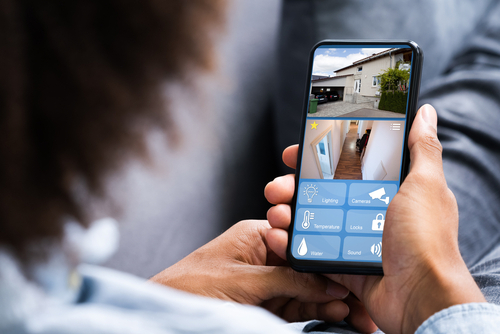Best home automation specialists in Symhurst, Gauteng
Top home automation specialists near you
Browse the best home automation experts and compare ratings and reviews.
Good price, great service. Quality workmanship all round
Chris is a pleasure to work with and has delivered outstanding work, thank you A+!
Hire the best home automation specialist
Search Uptasker for the best home automation specialists
Is home automation technology the answer when we are too busy to run our homes efficiently?
Recently, and due to sheer frustration, a very busy colleague I know who travels a lot for business said “I need to simplify my life by making my home more efficient. I just don’t have the time to run the house effectively with the time I have available”. He works long hours even when he is not travelling, and this makes complete sense in his case.
This has led him to investigate methods of controlling his home remotely – whether he is at home or away on business. What he has found is interesting.
Artificial intelligence is not new, but is becoming more prevalent all the time
Technology and automation are becoming more and more integrated into our everyday lives, on both a private and work level, and aspects of Artificial Intelligence (AI) has been in use for years, on a very low level, without us really being aware of it. To me, it is natural to assume that home automation must inherently involve some form of AI in its processing, but at the end of the day, it is the individual who controls the setup according to his or her requirements.
Home automation vs smart home – the difference :
When we talk about home automation, we are generally and unknowingly referring to a Smart Home setup. In a smart home setup, you directly control a class of electronic devices or sensors through the internet via a smartphone, computer, tablet, etc. In order to access these devices or sensors, you often use a separate app or interface designed specifically for them. Home automation, however, refers more to the central control of all these devices under one methodology, so that a series of steps work together automatically rather than you having to control each of them separately. It also aims to have these systems automatically work together in tandem with little or no direct input from the user. Basically explained, home automation will respond to whatever you are doing with a set of pre-programmed automatic actions which you do not have to directly control through any user interface or app. The essential form of AI!
Let’s look a little further at home automation
Home automation can be defined as :” ... the automatic and electronic control of household features, activity and appliances”. Put another way, it provides the user, via the internet, with direct control over predetermined utilities and features of their home, which allows for a more streamlined control of such utilities and features. This is done through a network of different interfaces such as hardware, communication and electronics, all of which are aimed at integrating different devices with one another using the internet as a communication platform. Through sensors installed in each device and connected through the WiFi system, you are able to manage them either on-site or remotely through your smartphone, PC or tablet. Whilst not all-encompassing at this point, you are able to turn lights off or on or adjust their brightness, lock and unlock the doors and security gates, adjust heat/cooling temperatures, control a sound system networked throughout the house, access external and internal security cameras, and even answer your doorbell via audio and visual cameras when you are not at home.
Home automation revolves around three main components, being :
Sensors, controllers and actuators form the three main components of any home automation system, and work in the following manner :
- Sensors. These monitor light levels (i.e. daylight, where sensors will automatically turn external security lighting on when light levels drop to a certain point), in much the same way as motion detectors work by sensing motion within their radius. Sensors may also be used to measure interior temperatures, and maintain a pre-set ambient temperature by automatically turning air conditioners and heaters on and off. Sensors can also be used to determine whether a room is occupied or not, and turn lights and cooling/heating devices off when the room is vacant.
- Controllers. These are the devices (computers, smartphones, laptops and tablets) which are the communication links between the devices and the automated features linked to them.
- Actuators. As the name implies, these are the actual switches or motors which control the mechanics of the automation system. These actuators are programmed by a controller which sends a remote command to the actuators.
A home automation system (HAS) can control the following :
Although the number of devices which can be controlled through this system is always increasing with developing technology, HAS can presently monitor and control linked devices such as :
- remote lighting, both indoor and exterior
- alarm systems
- thermostat control, aimed at keeping the house uniformly climate-controlled to pre-determined temperatures
- video surveillance – both live and static
- security systems and cameras
- exterior sprinkler systems, such as turning on the sprinklers before dawn or during the night when it is cooler and the water has more chance of being readily absorbed
- appliance control – i.e. reducing the fridge temperature when you are away for a long time by sensing that the fridge door has not been opened for a set period
- keyless entry systems / remote access control
- voice- and motion-activated systems
What are the advantages to be gained with HAS?
Home automation systems are a luxury item in some respects. Imagine living in a home where the temperature is always pre-set at a controlled level for optimum comfort at any time of the year without constantly having to fiddle with thermostat settings. Energy bills may be substantially reduced by thermostats automatically lowering the temperatures in rooms that you are not using – possibly activated by motion-control sensors. If you want to surround yourself with music or the daily news as soon as you walk in the door, you can have smart speakers set up to turn on the moment you open the front door, or certain lights to switch on throughout the house at particular times or when you open the front door – which is great when you regularly return to the house after nightfall. Internal cameras which can be remotely operated from your smartphone or tablet are a reassuring way of checking on what is happening in your home at any time.
You can, for instance, check that your dogs are not sneaking onto the couches during your absence, keep an eye on your children’s activities to ensure that they are, indeed, doing their homework and watch the activities of workers within your home when you are not on site yourself. Be aware, though, that home automation has the potential to invade general privacy, so everyone should be made aware that these cameras are, in fact, working and their actions can be monitored.
How to find the right home automation specialist for your needs
Check their online ratings and customer reviews
Home automation systems are still in the process of being rolled out and accepted globally, and it is a fairly new innovation on the whole. South Africa is catching up slowly with global trends in this regard, but it will take some time yet to become entrenched here. You may well find them by going through house and home magazines and catalogues, technical and technological publications, visiting home expos and speaking to architects and specialist building companies. Your best bet would probably be through searching online and using search sites such as Uptasker. Uptasker has the advantage in that it lists per geographical region, as well as providing online ratings and customer reviews which, at this point, could be considered essential factors by providing information on service levels, innovative ideas, and practicality, especially as no two homeowners will have exactly the same requirements. If possible, try to use word of mouth referrals from colleagues, if available, and get valuable feedback on how an automated home really works – the pros and cons – and whether it is the right choice for your own needs.
Top home automation specialist tips

If you are planning on going down the home automation highway, you need to be sure that you have taken all factors into consideration. If you are away from home for much of the time and want to keep an eye on your property from wherever you might be, this would certainly help to put your mind at rest. If you feel it necessary to have automated systems working in the background and accessible at the touch of a keypad – and which make your life less stressful and more streamlined, as well as giving you control over appliances and equipment from one central point, then this is probably the right move for you. Bear in mind, though, that nothing worthwhile comes cheap and problems may still occasionally crop up which could be extremely inconvenient if you are not on site at the time. For more tips, see our home automation specialist articles.
Read Home Automation articles







